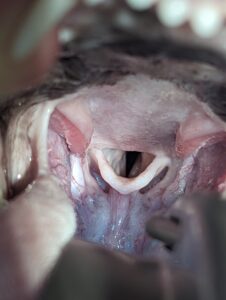 A good test that any owner of a brachycephalic dog can do is called the 25/30 test. This can be done at home/at the park, with the results then relayed to your vet.
A good test that any owner of a brachycephalic dog can do is called the 25/30 test. This can be done at home/at the park, with the results then relayed to your vet.
The test is performed as follows.
- On a 25-degree day, running your dog around down the park off lead for up to 30 minutes.
- Compare their breathing to a same aged normal-nose dog, such as a Labrador. (Not another brachycephalic that may be worse than yours, giving a false sense that they have “no breathing concerns”) Compare your dog with respect to the following:
- Do they puff and pant more quickly and with more effort than the normal-nose dog with the same degree of exercise?
- And far more importantly do they take longer to recover to a closed-mouth breathing pattern after the same degree of exercise?
Are there any differences: YES / NO
If the answer is yes, are those differences MILD, MODERATE or SIGNIFICANT?
If there is a difference, your dog will likely benefit from BOAS surgery and we recommend contacting your vet to organise this. If there is no difference, under conditions as close as possible to the above, monitor them for year-on-year “progression” of these differences compared to normal-nose dogs.
This “progression” and “degree of differences” is the most accurate way to understand their real breathing restrictions, and impact of BOAS. It is much more sensitive than an examination in the consult room.
The following will help you ascertain if differences are mild, moderate or severe:
If your dog can actually complete 30 minutes exercise (running, chasing, zooming etc. Not just walking) in 25 degrees celsius but shows no increased panting compared to a normal-nose dog, and is exhibiting closed-mouth relaxed breathing in 2-4 minutes after the 30 minutes, then there is no difference. In this case no benefits will be had from surgery. Just monitor and repeat the test each year.
However, if there is some increased panting during this exercise period, and it takes say 5-10 minutes to return to normal breathing, that’s mild differences. 10-20 minutes to recover shows moderate differences, and over 20 minutes to recover is the definition of significant differences
If you wouldn’t possibly allow 30 minutes exercise in 25 degrees as you know they will struggle, or you have tried but they can’t safely complete 30 minutes, then that’s also severe differences. (Please note: do NOT attempt this test if you are concerned your dog cannot complete it safely. In this case, please contact your vet to organise BOAS assessment).
Unfortunately, it has been found that in excess of 90% of owners notice differences that are at least moderate by 18 months, with many even younger than this. The only reason they show differences (mild, moderate or significant) is due to severe airway restrictions.
These dogs will almost always benefit from 5/5 airway-improvement surgery. They don’t always “need” surgery (they can often survive without it), but they do benefit from surgery. We feel the safest time to do it, with the best long-term results, are between 8-14 months, with around 12 months of age being ideal.
